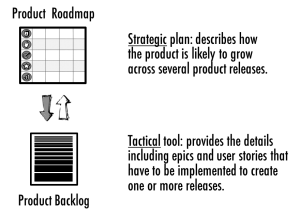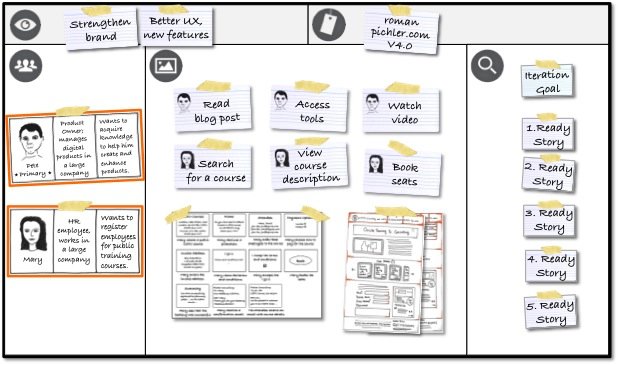10 Product Backlog Tips
Using the product backlog can be challenging, and many product owners wrestle with overly long and detailed backlogs. This blog post provides ten practical tips that help you work with your product backlog effectively.
Tip #1: Complement your Product Backlog with a Product Roadmap
Use a roadmap to sketch the overall journey you want to take your product on. State the upcoming major releases with their goals or benefits. Then derive your product backlog from the roadmap and use the goals to discover the right backlog items. This ensures that your backlog is aligned with the product strategy, and it helps you decide which items should be added to the product backlog and which should not.
Tip #2: Focus your Backlog on the Next Major Release
Use the product backlog as a tactical tool that states the product details–including epics and user stories–that have to be implemented to deliver the next major release. This results in a concise backlog, which is comparatively easy to update and change. The longer-term growth of your product should be captured on the product roadmap.
Tip #3: Start with a Short and Sketchy Product Backlog
Particularly when you create a new product or new features and keep the lower-priority items coarse-grained. Use the user and customer feedback to decide which feature to implement, to evolve the product backlog, and to refine its items. It’s OK, however, to have a longer, more detailed backlog when your product is mature and your focus is on incremental changes and bug fixes.
Tip #4. Collaborate with the Development Team
Involve the team members in the product backlog work. This allows you to benefit from their knowledge and creativity and discover technical risks and dependencies. It also increases the understanding and buy-in of the team members and results in better, clearer requirements.
Tip #5: Say No
Decline ideas and requirements that do not help you meet the release goal and move you closer to realising the product vision. This ensures that your product has a clear value-proposition and it prevents your product from getting bloated. If the idea or requirement is important but cannot be realised in the next few months, then consider adding it to the product roadmap.
Tip #6: Look beyond User Stories
While user stories and functional requirements in general are important, they are usually not enough. Also consider the user interaction, the nonfunctional qualities of your product, and the user interface and capture them in your product backlog.
Tip #7: Prioritise your Backlog
Use uncertainty and risk to decide how soon an item should be implemented. Addressing uncertain items early on allows you to test your ideas, to fail fast, and to learn how to continue. Complement risk with cost-benefit and take into account dependencies when necessary.
Tip #8: Proactively Manage your Product Backlog
Regularly groom and refine it together with the development team. Analyse the feedback and data collected from exposing the latest product increment to the users and apply the new insights to the backlog: remove and add new items, and update existing ones. This maximises the chances of building a product that users really want and it keeps the product backlog up to date and concise.
Tip #9: Get the Backlog Ready
Break larger items into smaller ones by leveraging the insights gained from exposing product increments to the users. Ensure that the high-priority items are ready for sprint planning: the items should be clear, feasible, and testable. This facilitates a realistic commitment, and it helps the team turn the items into a product increment without having to constantly ask you during the sprint what the user story means and if there is something missing.
Tip #10: Make your Product Backlog Visible and Easily Accessible
Try a paper-based backlog and put it on the wall. Such a backlog offers several benefits:
- It is clearly visible and creates transparency–assuming that it’s on the team room wall and people are colocated.
- It alerts you when your backlog is becoming too big, as you will be running out of wall space.
A tool like my Product Canvas helps you structure and visualise your backlog.
If using a paper-based product backlog is not possible, employ an electronic tool that is easy to use; or consider a mixed approach with some of the items on the wall and others–like the high-priority stories–in a tool like JIRA.
Learn More
You can learn out more about the product backlog by attending my Product Owner training course and by reading my book Agile Product Management wit Scrum.
Title picture published on Pexel under the Creative Commons Zero license.
| Reference: | 10 Product Backlog Tips from our JCG partner Roman Pichler at the Pichler’s blog blog. |




